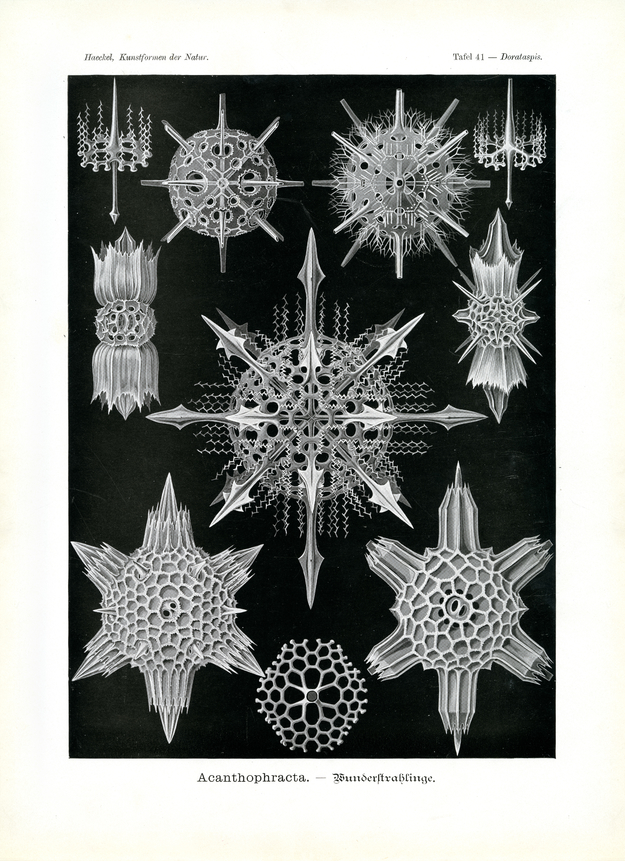Acanthophracta belong to the most marvelous and interesting formations that the unicellular organism of Protozoa can produce. These tender Radiolaria have developed out of the order of Acanthometra illustrated on plate 21; they too belong to the legion of Acantharia. The peculiar Acanthin skeleton of Acanthophracta covers the simple cell body in the shape of a grill shell that is characterized by a most tender and regular formation. Twenty quills form the base of the skeleton, spreading from the centre of the unicellular body, distributed according to the peculiar ‘Ikosakantha law’, already explained in the context of Acanthometra (see the explanation in plate 21). However, while these latter simply retain the twenty stings or may form simple free ‘grill plates’ with the help of their lateral appendices (plate 21, fig. 1, 2, 3), they are here uniting to form a complete ‘grill shell’. Pseudopodia emanating from the central capsule of the living cell body interpenetrate the gelatinous cover (Calymma) that separates them from the shell and protrude through the grill holes. (Plate 41 presents the cleaned skeletons only, not the soft bodies.)
Grill formation of the shell is different in the two main groups of Acanthophracta with one group growing two opposite lateral appendices (Diporaspida) on each ‘radial quill’ (on the surface of the Calymma), and the other with four cross-shaped lateral appendices each (Tessaraspida). In the first case, Diporaspida (fig. 1 and 2), two opposite Aspinal pores develop with the adhesion of the lateral appendices along the outflow of the sting, in the second case, however, Tessaraspida (fig. 3 and 4), four cross-shaped Aspinal grow. Later on, tender ‘additional quills’ usually form on the exterior side of the grill shell, in parallel direction to the twenty radial ‘main quills’ (fig. 2, 3 and 4). The original ball-shape of the shell (fig. 1-3) later changes into a lenticular form (fig. 9 and 10) and finally into the ‘double-cone-shape’ (fig. 6 and 7).
Translation of the original German introduction by Ernst Haeckel:
Phylum of Protozoa (Urtiere); - class of Rhizopoda (Wurzelfüßer); - subclass of Radiolaria (Strahlinge); - legion of Acantharia (Aktipyleen); - order of Acanthophracta (Wunderstrahlinge).
translation by VR Translators Bangalore.
This is one of the 100 pop science biology illustrations that were published from 1899 – 1904 in Leipzig by Ernst Haeckel through Verlag des Bibliographischen Instituts.
We've scanned the original lithography at 1200dpi on the Epson A3 scanner of A3 scanner huren. You can download a 400dpi JPEG here.
